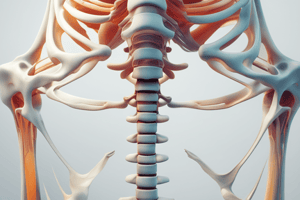Podcast
Questions and Answers
What is the main component of the inorganic matrix of bones?
What is the main component of the inorganic matrix of bones?
- Collagen fibers
- Hydroxyapatite (correct)
- Proteins
- Bone marrow
What is the function of bones in terms of movement?
What is the function of bones in terms of movement?
- To act as levers for muscles to pull on (correct)
- To store minerals
- To produce blood cells
- To regulate body temperature
What type of bone is characterized by a shaft and two ends?
What type of bone is characterized by a shaft and two ends?
- Short bone
- Long bone (correct)
- Irregular bone
- Flat bone
What is the process of bone formation?
What is the process of bone formation?
What is the function of bone marrow?
What is the function of bone marrow?
What type of bone tissue is found in the cavities of bones?
What type of bone tissue is found in the cavities of bones?
What is the process of bone growth?
What is the process of bone growth?
What is the function of bones in terms of storage?
What is the function of bones in terms of storage?
Study Notes
Structure and Composition
- Bones are rigid, calcified structures that make up the skeleton
- Consist of:
- Organic matrix (35%): collagen fibers, proteins, and other organic compounds
- Inorganic matrix (65%): hydroxyapatite, a form of calcium phosphate
Functions
- Support and protection: provide framework for the body and protect internal organs
- Movement: act as levers for muscles to pull on, enabling movement and locomotion
- Blood cell production: bone marrow produces blood cells, including red blood cells, white blood cells, and platelets
- Storage of minerals: bones act as a reservoir for minerals such as calcium and phosphorus
- Endocrine functions: produce hormones that regulate bone growth and development
Types of Bones
- Long bones: characterized by a shaft (diaphysis) and two ends (epiphyses), e.g. femur, humerus
- Short bones: cube-shaped, e.g. carpals, tarsals
- Flat bones: thin and flat, e.g. ribs, sternum
- Irregular bones: complex shapes, e.g. vertebrae, pelvis
- Sesamoid bones: small, round bones embedded within tendons, e.g. patella
Bone Tissue
- Compact bone: dense, compact tissue found in the shafts of long bones
- Cancellous bone: spongy, porous tissue found in the ends of long bones and the interior of flat bones
- Bone marrow: spongy tissue found in the cavities of bones, responsible for blood cell production
Bone Development and Growth
- Ossification: process of bone formation, can occur through intramembranous or endochondral ossification
- Bone growth: occurs through the process of apposition, where new bone tissue is added to the surface of existing bone
- Bone remodeling: process of bone resorption and formation, essential for bone maintenance and repair
Bone Composition
- Bones are composed of 35% organic matrix (collagen fibers, proteins, and other organic compounds) and 65% inorganic matrix (hydroxyapatite, a form of calcium phosphate)
Functions of Bones
- Provide framework for the body and protect internal organs through support and protection
- Enable movement and locomotion by acting as levers for muscles to pull on
- Produce blood cells, including red blood cells, white blood cells, and platelets through bone marrow
- Act as a reservoir for minerals such as calcium and phosphorus through storage
- Regulate bone growth and development through endocrine functions
Classification of Bones
- Long bones have a shaft (diaphysis) and two ends (epiphyses), e.g. femur, humerus
- Short bones are cube-shaped, e.g. carpals, tarsals
- Flat bones are thin and flat, e.g. ribs, sternum
- Irregular bones have complex shapes, e.g. vertebrae, pelvis
- Sesamoid bones are small, round bones embedded within tendons, e.g. patella
Bone Tissue Types
- Compact bone is dense, compact tissue found in the shafts of long bones
- Cancellous bone is spongy, porous tissue found in the ends of long bones and the interior of flat bones
- Bone marrow is spongy tissue found in the cavities of bones, responsible for blood cell production
Bone Development and Growth
- Ossification is the process of bone formation, which can occur through intramembranous or endochondral ossification
- Bone growth occurs through the process of apposition, where new bone tissue is added to the surface of existing bone
- Bone remodeling is the process of bone resorption and formation, essential for bone maintenance and repair
Studying That Suits You
Use AI to generate personalized quizzes and flashcards to suit your learning preferences.
Description
Learn about the structure and composition of bones, their functions, and how they support the body. Explore the organic and inorganic matrices that make up bones and their role in movement and blood cell production.





